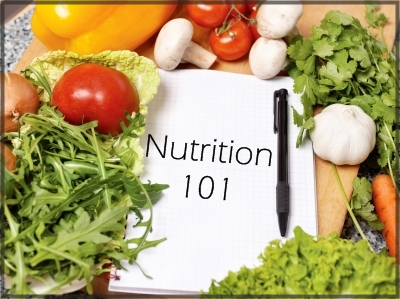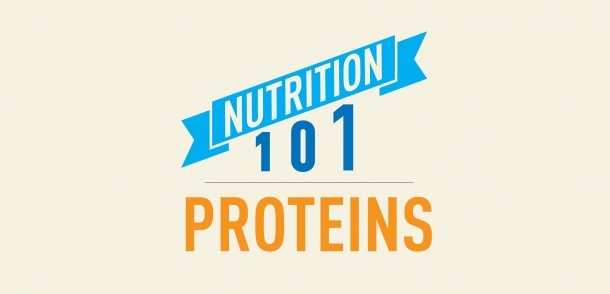 Whether you’re wanting to lose weight, gain muscle, recover from a tough workout, feel more satiated at mealtime or simply maintain good health, eating adequate amounts of healthy sources of protein is important.
Whether you’re wanting to lose weight, gain muscle, recover from a tough workout, feel more satiated at mealtime or simply maintain good health, eating adequate amounts of healthy sources of protein is important.
A crucial component of every cell in the body, protein is used to build and repair tissues (like skeletal muscle, bone, hair, fingernails, cartilage, skin and blood) as well as make enzymes and hormones. Like carbohydrate and fat, protein also provides energy, but because it has so many other important functions and can’t be stored, the body relies heavily on carbohydrate and fat for energy. This leaves protein free to be used for maintaining healthy tissues, enzymes and hormones.
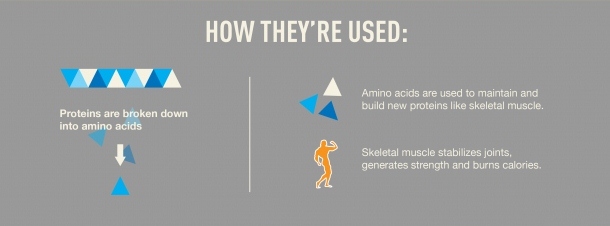 Shortly after a meal, proteins are digested into amino acids. These amino acids, or protein building blocks, are absorbed by the small intestine and then distributed to cells in the body. This process of breaking down proteins to amino acids is a very thermogenic process meaning it takes calories to allow this process to happen. In fact it can use two thirds of the calories contained in the protein eaten just to digest it. This process also take time to complete thus keeping you full and satisfied for a longer period of time. This makes it a very diet friendly nutrient when controlling your weight and cravings.
Shortly after a meal, proteins are digested into amino acids. These amino acids, or protein building blocks, are absorbed by the small intestine and then distributed to cells in the body. This process of breaking down proteins to amino acids is a very thermogenic process meaning it takes calories to allow this process to happen. In fact it can use two thirds of the calories contained in the protein eaten just to digest it. This process also take time to complete thus keeping you full and satisfied for a longer period of time. This makes it a very diet friendly nutrient when controlling your weight and cravings.
In addition to helping us feel satiated after a meal, dietary protein plays a critical role in every cell–building and maintaining healthy tissues and producing important enzymes and hormones that help regulate metabolism, growth and many other things.
The cells take what they need and rearrange amino acids to make new proteins or repair older ones. Because the body doesn’t store protein, once our basic needs have been met, any excess is either used or stored as energy. Amino acids may be converted into glucose, and subsequently glycogen, if the body is short on carbohydrates. They may also be converted into fatty acids and stored as fat.
How Much Protein Do You Need?
It’s important to get enough protein throughout the day but it’s also important not to go overboard. Protein tends to play a starring role at mealtimes, but you might be better off if it moves out of the spotlight and becomes part of a supporting cast of foods on your plate. Most Americans get more than enough protein each day. Although important in the diet, extra protein will not help you build more muscle or make you stronger. When you’re consuming too much of it, you’re probably taking in more calories and fat than your body needs and just like carbohydrates and fat, can lead to undesired weight gain if calories in exceed calories out.
 Adults in the U.S. are encouraged to get 10% to 35% of their day’s calories from protein foods. That’s about 46 grams of protein for women, and 56 grams of protein for men.
Adults in the U.S. are encouraged to get 10% to 35% of their day’s calories from protein foods. That’s about 46 grams of protein for women, and 56 grams of protein for men.
It’s not hard to get this amount if you eat two to three servings of protein-rich foods a day, according to the CDC.
- A small 3-ounce piece of meat has about 21 grams of protein. A typical 8-ounce piece of meat could have over 50 grams of protein.
- One 8-ounce container of yogurt has about 11 grams of protein.
- One cup of milk has 8 grams of protein.
- One cup of dry beans has about 16 grams of protein.
 Tips for Not Going Overboard With Protein
Tips for Not Going Overboard With Protein
Protein servings of meat, poultry, or fish, should be the size and thickness of the palm of your hand. That’s about a 3-ounce portion. To look at it another way, protein should take up no more than one-fourth of your plate at meals. Including small amounts of protein foods at every meal to spread your intake evenly throughout the day is the best way to keep yourself feeling satisfied and full after meals and snacks.
People With Special Protein Needs
Not everyone needs the same amount of protein. Here are six groups who need to pay more attention to their protein requirements.
Pregnant and breastfeeding women – pregnant women need about 10 more grams of protein than they did before. And “nursing women need 20 grams more protein a day than they did before pregnancy to support milk production. You would get 10 grams in one Greek yogurt or a half-cup of cottage cheese, so it doesn’t add up to a lot of food. Pregnant women are encouraged to get 20 to 30 grams of their protein a day from low-fat dairy products because calcium and vitamin D are crucial for the bone health of mother and baby. Check with your Obstetrician if you are unsure.
Athletes – Most sports involve physically breaking down muscle during the activity and repairing it afterward. So the protein needs of active people are influenced by the length, frequency, and intensity of their workouts. Endurance athletes such as marathoners need about 50% more protein than a sedentary person.
Dieters – When shedding pounds sensibly, the goal is to lose body fat but maintain lean muscle mass. Protein helps you do that. Protein foods tend to be more filling, so they delay hunger, making it easier to stick with your weight-loss program. Just keep an eye on the calories and portion sizes of your protein choices when including them in meals and snacks.
Vegetarians – which protein foods — meat, fish, eggs, or dairy — are being included or excluded from the diet can make the difference in how much protein is needed. As long as vegetarians are eating a variety of healthy foods, they should be able to get the recommended amount of protein from sources other than meat.
Vegans – People who don’t eat any animal products depend on beans, dried peas, and whole grains as their main sources of protein. Vegetables, nuts, and seeds also contain small amounts of it. Vegans can meet their protein needs, but it takes careful planning and may require more food to do so.
Protein is found in a variety of foods: meat, poultry, fish, dairy, eggs, legumes, nuts, seeds, soy and even grains. From a dietary perspective, meats, poultry, fish, eggs, and soybeans are complete proteins, that is they provide all of the amino acids required by our body. Other protein foods like legumes, some nuts and seeds, and grains, don’t provide adequate amounts of the essential amino acids by themselves but can when eaten in combination with other foods and as part of a balanced diet.
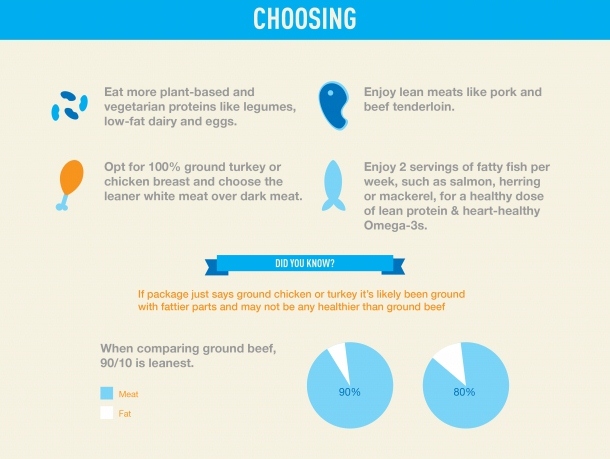 Best Protein Sources
Best Protein Sources
Although also considered proteins, most people benefit from eating less processed protein, such as bacon, hot dogs, and lunch meats. I encourage people to choose lean forms of protein, that way it has minimal extra baggage like fat. Meat eaters, should choose lean cuts like pork and beef tenderloin. A general rule of thumb when shopping: cuts that have round, chuck, or loin in the name are usually lean. Some cuts may take a bit longer to prepare (try marinating or braising) but if prepared right, they’re equally as delicious as some fattier cuts. Since ground meats are typically high in fat, look for the leaner options, like 90/10 ground beef, which contains 90% lean meat and only 10% fat. And if you’re a steak or burger-lover like I am, feel free to indulge every-so-often, but limit red meat to once or twice per week since it is high in saturated fat.
Skin aside, poultry is generally lean–but beware when buying ground chicken or turkey. Unless it says 100% ground turkey breast (or chicken breast) on the package, the meat has likely been ground up with the skin and fat, which means that turkey burger may not be any healthier than one made from ground beef.
If you enjoy fish, aim to eat 3-4 ounces of it twice per week. Frozen or fresh, fish can be a great source of protein. Some–like salmon–are even rich in Omega-3s, a healthy, unsaturated fat.
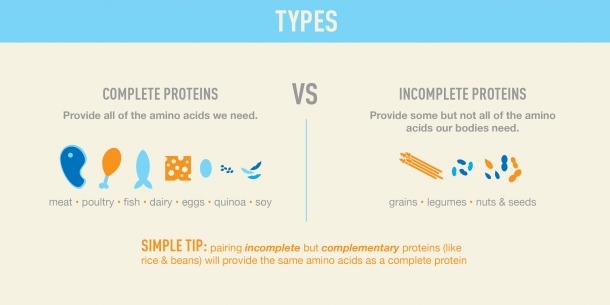 In addition, Vegetarian or not, we can all benefit from eating more plant-based proteins. Foods like beans, peas, quinoa and lentils, as well as low-fat dairy and eggs, are rich in other nutrients like fiber, vitamins and minerals.
In addition, Vegetarian or not, we can all benefit from eating more plant-based proteins. Foods like beans, peas, quinoa and lentils, as well as low-fat dairy and eggs, are rich in other nutrients like fiber, vitamins and minerals.
From black beans and garbanzos to lentils and split peas, plant proteins can be used in soups, chili, spreads, and Mexican dishes. As for whole grains, three protein-rich grains are quinoa, spelt, and amaranth.
Unlike animal protein, most plant-based proteins are “incomplete,” meaning they lack some amino acid building blocks. By combining plant proteins, such as rice and beans or hummus on pita bread, they become “complete” with all the essential amino acids found in animal protein. Eat different plant proteins anytime during the day. They don’t need to be eaten in the same meal.
You may also like:
- Six Weeks to a Healthier Diet
- Smart Start Menu Series
- Tips for putting together healthy menus
- Walk Talk Series
Catch up on the whole Nutrition 101 series:
Just click on the link to take you to the topics in the series
- Nutrition 101 – Introduction to basic Nutrition
- Nutrition 101 – Calories
- Nutrition 101 – Carbohydrates
- Nutrition 101 – Proteins
- Nutrition 101 – Fats
- Nutrition 101 – Micronutrients ( Vitamins and Minerals)
- Nutrition 101 – Fiber
- Nutrition 101 – Water
- Nutrition 101- Recap – 5 Tips to Eat More Nutritiously

